It’s been a while since I’ve written a load of waffle, so I figured now was as good a time as any, as I sit in Jakarta airport awaiting my flight out of Indonesia (which by the way is a pretty rubbish airport on the whole but is in the process of being upgraded over the coming years thankfully). Anyway, back to Papua and my last tour of 2013 in the lead up to Christmas.
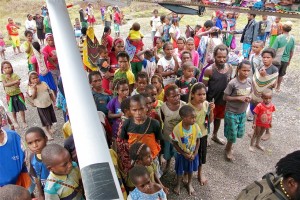 |
| Local people of Jila, Papua |
My tour started with a house move which as anyone will tell you is one of the more stressful things to-do in this world. But imagine doing it in the third world with all the extra frustrations you get. One bonus is labour is cheap so you get plenty of help but even when your company is arranging everything, it’s never straight forward.
 |
| Airport terminal in Tuput, Papua |
The first hurdle was getting enough electricity supplied to the house to power such luxuries as air conditioning, running water, a hot water tank and an electric oven. The average house, in the more remote parts of Indonesia, is only really designed to run a few light bulbs, a TV and possibly one air conditioner in the bedroom. Oh and a karaoke machine. It took three attempts at rewiring the house to get it to a stage where the wiring doesn’t catch fire or trip the circuit breakers at 2am…
The other key thing we needed, was a decent internet connection; sadly that’s still pending as although it’s apparently connected and working I’ve found the 3G on my phone to be faster. The trouble is it’s very difficult to get an honest answer as to what the problem is because Indonesians don’t like to disappoint so will tell you anything, in their mind, to keep you happy. At least the satellite TV’s working and the power seems to be ok now, so we’re getting there slowly.
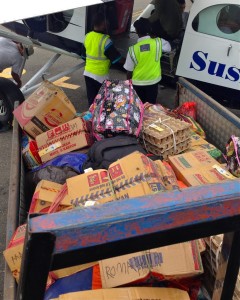 |
| Christmas cargo from Timika to the mountains of Papua |
As far as flying goes it’s been business as usual in Timika although the lead up to Christmas is always much busier with lots of extra subsidy flights scheduled to help the local people get back to their villages for Christmas. Most Papuans are Christian so Christmas is a big deal for them. And that means lots of noise in the form of fireworks and firecrackers. The local kids just love them and it feels like you’re living in a war-zone at night time with all the pops and bangs.
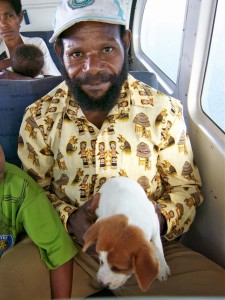 |
| Cute pax (the puppy that is) |
When it comes to the flights themselves, the locals like to bring back as much food as possible to their villages in preparation for Christmas. Mainly rice (as it isn’t grown much in the mountains), palm oil, salt, noodles, chickens, biscuits and plastic plants (strangely). What they don’t quite understand (and nor to our check-in staff) is that the Porter is not a big aircraft, especially when there’s 6 or more people plus all their food and baggage. I had one flight of 5 passengers where the passengers had over 100kgs of luggage each!
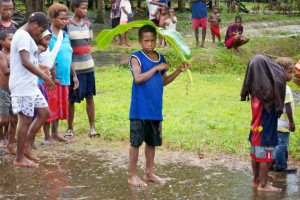 |
| Local boy trying to stay dry in Jita, Papua |
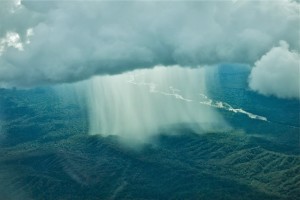 |
| Isolated shower during the wet season in Papua |
If you’ve been following my Instagram or Facebook feeds, you’ll have noticed a few photos highlighting the wet season here in Papua. It certainly makes flying more challenging and I actually quite enjoy it. When you’re doing the same subsidy airstrips every day, sometimes more than once a day, the weather adds an additional challenge to conducting a safe flight. It does however mean lots of flying about in clouds (IMC) and relying on pre-determined GPS tracks at or above safe altitudes to keep you out of the side of a mountain. I’m not really a fan of flying about without the nice views but it’s a safer and more efficient way of conducting the en-route part of a flight than trying to dodge around them all. Obviously you have to be visual to make the approach and landing which is where the additional challenges lie.
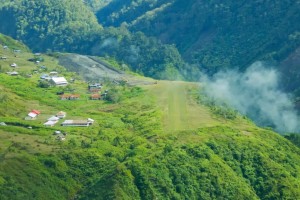 |
| New airstrip under construction at Mapnduma, Papua |
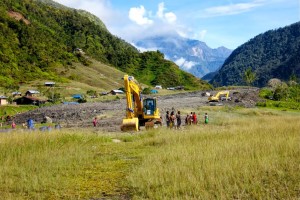 |
| Airstrip extension in Mapnduma, Papua |
The wet weather hasn’t stopped the continual development of Papua however. The tricky 400m length of slippery rock/grass at Mapnduma is sadly being destroyed to make way for a 750m asphalt monster which will forever change the village once the larger aircraft start coming in. There’s also a huge road project to link the town of Kenyam on the southern flatlands though to Wamena in the central highlands. It’ll pass though Paro, Mapnduma and various other villages on the way. Whilst it’ll certainly reduce the amount of cargo needing to be flown, the aircraft will still continue to be needed as you can’t build roads everywhere.
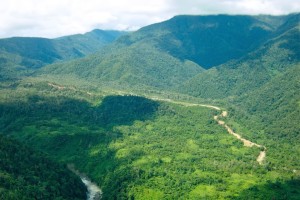 |
| Road at Paro being constructed between Kenyam and Wamena, Papua |
I’ll leave you all with this photo of a special VIP passenger I flew from Mapnduma to Paro the other day. Some of you might recognise him as the star of my “When Natives Go Wild” blog entry from a few months back. Not really a face I could forget as he charged towards me yielding a machete and spear! He seemed to have calmed down a bit since we last met thankfully although I had another chap charging around with a machete last week in Mapnduma. Must be something in the water..
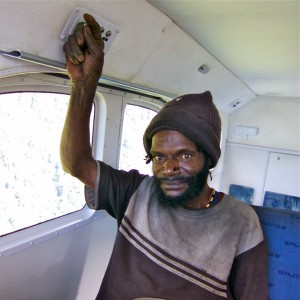 |
| Local guy who attacked me the other month(!) |











So I suppose he was OK with you taking his picture this time? 😉
Yeah, he was much more normal this time around thankfully. Who know what he’d been smoking/drinking last time we met!